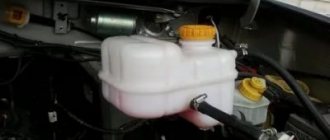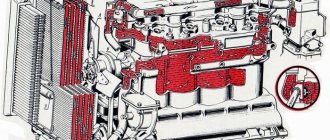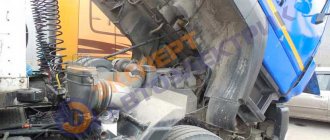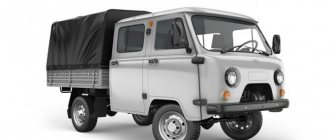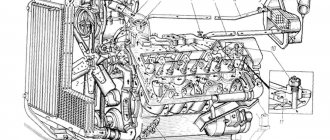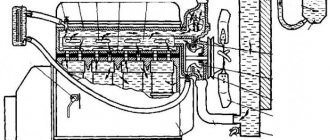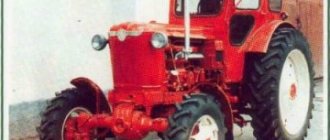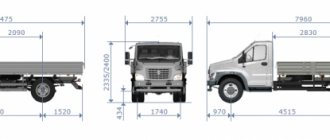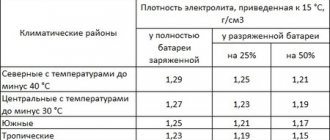GAZ-66 is a family of Soviet and Russian off-road trucks produced in the period 1964-1999 in Russia and Ukraine. This model is considered the most popular all-wheel drive two-axle truck in the USSR Armed Forces. The car was designed by GAZ and has many modifications based on the GAZ-66. Their total production volume exceeded 960 thousand copies.
The load capacity of the GAZ-66 is 2000 kg, and it is also capable of moving in difficult off-road conditions thanks to the presence of cam differentials, high ground clearance and tire pressure adjustment. In city or highway conditions, the GAZ-66 with the ZMZ-513 engine reached a maximum speed of 90 km/h.
How much oil to pour into the engine of a GAZ 66 car
First generation 1964-1995
The ZMZ-513 engine was installed on GAZ-53, 66, 3307, etc. cars. The engine has a specially shaped sump and a shielding system using special electrical equipment, which ensures durability in extreme military conditions and in agriculture. The design of the ZMZ-513 engine provides a V-shaped arrangement of eight cylinders and a displacement of 4.25 liters.
Power is 97 kW at 3400 rpm or 125 hp. s., which made the 513th the most powerful engine for that time. The engine is based on an aluminum block on which cylinder heads (2 pieces) with a camber angle of 90 degrees are located. There is only one camshaft, and the intake manifold is mounted between the heads. The manifold houses a carburetor, filter and other auxiliary components.
Gasoline engines 1964-1993
ZMZ 513 4.2 liters (125 hp), oil volume - 10 liters; tolerance and viscosity: API-SG, SH; SAE 15W-40, 10W-40
The radiator is designed for intensive cooling of liquid. The ZMZ-66 engine is equipped with a tubular-plate radiator, consisting of an upper tank, a core and a lower tank. The radiator is installed in front of the engine and is attached to the frame at two points through rubber pads.
The upper tank, made of brass, has a filler neck closed by a plug with steam and air valves, a coolant temperature warning lamp sensor and a pipe for connecting the supply hose. The steam valve opens at an excess pressure in the system of 0.45-0.60 kgf/cm2 and releases steam into the atmosphere. The air valve opens at a vacuum of 0.01 - 0.12 kgf/cm2 and lets atmospheric air into the radiator.
The core consists of three rows of brass tubes, between which plates are soldered to increase the heat transfer area.
The core is enclosed in a stamped frame, soldered to the radiator tanks.
The lower tank is made of brass, has a pipe for connecting to the water pump and a drain tap. Behind the radiator is a fan shroud that directs airflow through the radiator.
The water pump is designed to create forced circulation of coolant in the system. Centrifugal pump. It is mounted on the front of the engine and receives drive from the crankshaft pulley through a V-belt. The water pump (Fig. 20) consists of a housing, a cover, a roller with bearings, an impeller, a sealing device, and a fan drive pulley hub.
Rice. 1. Cooling system of the ZMZ-66 engine: 1 - radiator; 2 - hose and pipeline; 3 - fan; 4 water pump; 5 — heater valve; 6 — thermostat; 7 — cooling jacket; 8 — coolant temperature indicator sensor; 9 - filling funnel of the starting heater: 10, 11 drain taps: 12 - blinds
Rice. 2. Water pump of the ZMZ-66 engine: 1 - fan hub; 1 - roller; 3 - cover; 4 - control hole for lubricant exiting the housing; 5 - oiler; 6 — impeller; 7 - inspection hole for coolant outlet if the oil seal is damaged; c— spring, 10 gland cage; 11 — oil seal cuff; 12 — oil seal washer; 13 — seal ring
The pump housing is integral with the timing gear cover. The lid is made of cast iron. It has a roller mounted on two ball bearings. The cover on top has an oil nipple and a control hole for the release of lubricant, and at the bottom there is a control hole for the release of coolant in case of damage to the oil seal. The bearings are lubricated with YANZ-2 grease through a grease nipple until the grease comes out of the control hole.
The roller has flats at the ends. An impeller is pressed onto one end of the roller, and a pulley hub is pressed onto the other end. The bearings are secured in the cover with a retaining ring that fits into a groove in the cover.
The pump impeller is made of plastic (fiber) and is secured to the shaft with a nut.
The sealing device (oil seal) prevents liquid leakage. The oil seal consists of a cage, a spring, a rubber cuff, a textolite washer and a locking ring.
The thermostat is designed to automatically regulate the temperature of the coolant in the engine cooling system and to speed up its warm-up after starting. A liquid thermostat is installed in the ZMZ-66 engine cooling system.
The liquid thermostat consists of a housing, a corrugated cylinder and a valve. The cylinder is filled with an easily evaporating liquid. The valve has a small hole or recess on the edge to remove air from the engine cooling jacket. If this hole is clogged with scale, then when liquid is poured into the radiator, air pockets form and the system cannot be completely filled.
When the coolant temperature is below 78 °C, the cylinder is in a compressed position and the valve is closed, as a result of which the coolant does not enter the radiator, but exits through the thermostat windows. When the temperature rises to 83 °C, the liquid and vapor increase in volume, and the corrugated cylinder, expanding, acts on the valve stem and opens it. At a temperature of 91° C, the valve opens completely and all the liquid is directed to the radiator.
The fan is designed to create a cooling air flow through the radiator. The fan is six-blade, made of sheet steel. The fan is driven by a V-belt from the crankshaft pulley together with the water pump. The fan blades have bent ends, which provides better flow distribution along the side surfaces of the engine. The tension of the drive belt of the water pump and fan is carried out by changing the position of the generator. When pressed with a force of 4 kgf, the deflection in the middle of the branch should be 10-15 mm.
Blinds are designed to regulate the flow of air through the radiator. The blinds are installed in front of the radiator and are a set of plate-leafs, hingedly fixed in the frame. The blinds are driven from the vehicle's cabin using rods and levers.
To monitor the temperature of the coolant in the cooling system, use the “water” indicator lamp installed on the instrument panel. The normal temperature of the coolant in the engine should be between 80-90 °C.
Rice. 3. Cooling system thermostat: a - closed: b - open; 1 — inlet pipe: 2 — thermostat housing; 3 - thermostat valve: 4 - outlet pipe: 5 - rod: 6 - cylinder
The coolant from the cooling system is drained through four taps; one of them is located in the lower radiator tank, the second is on the right side of the cylinder block, the third is on the starting heater boiler and the fourth is on the cabin heater hose.
Cooling system operation. The rotation of the engine crankshaft drives the water pump and fan through the drive. When the impeller rotates, a vacuum is created in the receiving cavity of the water pump. Due to the vacuum, the coolant flows from the lower radiator tank into the water pump, and from it is pumped into the cooling jacket of the cylinder block, from there into the jacket of the cylinder heads and then to the thermostat. If the coolant temperature is less than 78 °C, the thermostat is closed and the coolant circulates, bypassing the radiator. This achieves quick warm-up of the engine. When the coolant temperature reaches 78-83 °C, the thermostat opens and the coolant circulates through the radiator, being cooled there by the air flow created by the fan.
Reviews
Sergey, Moscow region. The GAZ-66 has exceptional cross-country ability, which increases confidence in overcoming various kinds of obstacles on rough terrain. The main disadvantage can only be called high fuel consumption, and noise and vibration can be tolerated. The so-called “Shishiga” has no competitors on off-road terrain; it has a low center of gravity and phenomenal stability.
Bogdan, Udmurtia. I worked for GAZ-66 almost all over Russia. I had a chance to travel along the rivers and lakes of Eastern Kazakhstan, where there are practically no roads. We also climbed the Irtysh, mountain lake Markakol, etc. On these natural “forays” the car showed itself in all its glory - where foreign cars could choke. In general, the GAZ-66 can still be recommended to fishermen and hunters. It’s better to buy from the database and then cover it with all sorts of extras at your discretion.
Design features of the GAZ 66 (ZMZ 511) engine
The gasoline internal combustion engine has a carburetor-type power supply system.
- Cylinders with a diameter of 92 mm are located at right angles.
- The distance between the axes of adjacent cylinders is 123 mm.
- The pistons drive the crankshaft.
- The engine is equipped with a closed liquid cooling system.
- The coolant circulates under the influence of a special pump - forced cooling.
- The lubrication system operates both under pressure and by spraying oil - combined.
Service
Since the design of the ZMZ 513 engine is similar to the 511, it is serviced identically. Scheduled maintenance is carried out every 15,000 km.
So, in order to increase the resource of the power unit, it is necessary to carry out scheduled maintenance correctly and most importantly on time. Many motorists do not understand what should be included in this process. So, let’s look at what operations are included in scheduled maintenance:
- Replacing engine lubricant.
- Replacing the oil filter element.
- Adjustment of the valve mechanism (every 30,000 km).
- Replacing the air filter (after 25,000 km).
- Diagnostics of spark plugs (every 20,000 km).
- Checking the condition of the gas distribution mechanism (every 30,000 km).
If you look at it, often motorists only change the oil and filter. Valve adjustment is carried out only if a characteristic metallic ringing is already heard.
Repair
Since the motor was developed on the basis of the 511, the problems are the same as those of its older brother. The main problem can be considered the cooling system. By and large, the owners of the power unit are to blame themselves, since they operate the engine on water, which leads to corrosion of the main structural elements. Also, it is worth noting that the weak link of the unit can be called the thermostat and the water pump, which quite often fail.
The disadvantage of the engine is increased fuel consumption. Many motorists have experimented with reducing fuel consumption. The most effective option remains replacing the carburetor.
Engine owners prefer to repair the GAZ 66 engine themselves, but when it comes to major repairs, they cannot do without special equipment. In this case, the power unit is sent to a specialized car service.
Change of oil
Replacing the lubricant in the engine is quite simple. We wait until the engine cools down. We find the drain hole and place a container under it in the size of 10 liters. Typically, the ZMZ 513 engine fits 9.6 - 9.8 liters. Now that everything is ready, you can proceed directly to the work of changing the oil:
- Unscrew the drain plug.
- We wait until the oil drains.
- We tighten the drain plug, replacing the o-ring.
- Pour oil through the filler neck.
As practice shows, a large number of owners of the ZMZ 513 engine use motor oil marked M-10 or M-10G.
It is perfect for this power unit and has all the necessary technical and physical properties to ensure normal operation and protection of engine parts.
Tuning
Despite the fact that the ZMZ 66 engine has long been out of production, car enthusiasts do not give up trying to improve it. True, it is not possible to use chip tuning in this case, since this motor is controlled without an electronic control unit (ECU).
In general, you can improve the performance of the ZMZ-66 power unit in several ways:
- Adjust the engine for the installation of modern gas distribution mechanisms.
- Replace the carburetor fuel supply system with an injection system.
- Install a turbocharging system.
These methods will increase the power and efficiency of the old engine, but will require a lot of time and high material costs.
Specifications
Overall dimensions of GAZ 3307:
- length – 6550 mm;
- width – 2380 mm;
- height – 2350 mm;
- ground clearance - 265 mm;
- wheelbase – 3770 mm;
- rear track – 1690 mm;
- front track – 1630 mm;
- platform length – 3490 mm;
- platform width – 2170 mm;
- platform height – 510 mm.
The total vehicle weight is 7850 kg, curb weight is 3200 kg. The car is capable of carrying up to 4500 kg of cargo.
Other characteristics and fuel consumption:
- maximum speed 90 km/h;
- acceleration to 80 km/h – 64 sec;
- fuel consumption at 60 km/h – 19.6 l/100 km;
- fuel consumption at 80 km/h – 26.4 l/100 km;
- fuel tank volume – 105 l;
- the maximum climbable height is 25%.
For GAZ 3307, wheels of size 152B-508 are used, tires are 8.25R20.
Dimensions Gas-53
The weight of the vehicle is 3200 kilograms, with a maximum load of 7850 kilograms. The documentation states that Truzhenik can transport cargo weighing up to 4500 kilograms (the first versions up to 3000 kilograms). In fact, it is capable of transporting both 5 and 6 thousand kilograms, but in this case an immediate replacement of the Gas-53 springs will be required.
The length of the truck is 6400 centimeters, width - 2400 cm. When unloaded, the height is 2200 centimeters. When fully loaded, it reaches speeds of up to 90 km/h, and “empty” - up to 110 km/h.
The Gas-53 rear axle is separated from the front axle by 3700 centimeters. Ground clearance (265 millimeters) allows you to overcome medium and small obstacles, as well as shallow water obstacles.
Under ideal road conditions (flat road, above-zero temperature and no precipitation), zero congestion and a speed of 40 kilometers per hour, fuel consumption is 24 liters per 100 km. Practice shows consumption of 27 liters per 100 km when there is no load. When fully loaded, consumption increases to 30 liters.
Gas oil volume 66. Filling containers and standards
The GAZ-66 all-wheel drive truck became a living legend even during the years of its mass production. More than half a century after its creation, this unique machine continues to be widely used both by organizers of hunting raids and resort rides, and by those who often have to deal “not with roads, but with directions.” Such a long service of the GAZ-66 was ensured by its excellent off-road characteristics, with a relatively compact size and simple design.
An important role in the continued active practical use of this model was also played by the fact that many of these vehicles are today in fairly decent technical condition.
Due to the fact that during the period of withdrawal of the GAZ-66 from the armed forces, many people had a real opportunity to purchase this army all-terrain vehicle, which had been removed from conservation, for relatively little money. And there were a lot of them stored for conservation!
The GAZ-66 was popularly nicknamed “shisharik” or “shishiga”. Not by analogy with “the relatives of the devil who live in the reeds” (the meaning of the ancient Slavic word “shishiga”), but simply by consonance with the phrase “sixty-six”.
Replacing the GAZ 66 engine
When tuning a GAZ 66 car, the power unit is often replaced with a diesel one. Most often, instead of the GAZ 66 (ZMZ 511), a diesel internal combustion engine D-245, produced at the Minsk Motor Plant, is installed. Diesels of this series are equipped with turbocharging.
Interesting: By order of Nicaragua, the manufacturer is re-equipping GAZ 66 series cars. Instead of the original engines, they are equipped with new Minsk diesel engines D 245. If you wish, you can make an individual order here to modernize your car.
The appearance of the motor
Calculations for the car and power plant began at the turn of the fifties. Initially, the vehicle was intended for universal use, like an all-terrain vehicle. The military was primarily interested in the product; agriculture also needed such devices. It is no coincidence that the car was used by geologists, workers in the oil and forestry industries.
When creating the car, the GAZ 66 engine was also developed from scratch; the technical characteristics of the installation corresponded to the trends of that time, ahead of competitors. The creation of the unit was the responsibility of designers and engineers who took the work seriously, and as a result, the set conditions were met. The motor turned out to be simple, reliable, durable, and the product was repaired in the field.
The first cars rolled off the assembly line in 1962, and serial production of cars began in 1964. The “finest hour” of GAZ 66 came in 1967, when the Gorky – Vladivostok – Gorky run was organized. The vehicle easily covered the route, part of which was off-road (Ural, Siberia, Transbaikalia, Far East). Both the car and the engine passed the test with honor, without receiving any serious damage.
Production of the car continued until 1995; later the unit was replaced by the GAZ-3308, which replaced the modification. The improved ZMZ-513 power plant, used on the 66th, is still produced today. The product is used on other modifications of GAZ vehicles, including “3308”.
Motor "ZMZ-66":
The main problems of GAZ 66 (ZMZ 511) engines and their modifications
All internal combustion engines of this series have similar faults and typical problems:
- Oil drips in the area of the main bearing seal located at the rear.
- Reduced pressure in the engine lubrication system.
- Increased engine oil consumption.
If a situation arises when oil consumption exceeds 0.4 liters over a mileage of 100 kilometers, and the instruments show a sharp decrease in pressure in the lubrication system, it is necessary to send the vehicle for diagnostics with subsequent repairs.
Tip: If the pressure control device is faulty, it can be replaced with a pressure gauge. Before measuring pressure, the power unit should be thoroughly warmed up. Normal pressure is considered: in idle mode - 0.5 kgf/cm2. or 1 kgf/cm2 at medium speed.
If the oil pressure in the system is too low, it is strictly forbidden to operate the vehicle.
A decrease in compression in the cylinders is also a negative factor indicating a malfunction of the internal combustion engine. Compression is measured with a special device called a “compression meter”. Before using it you must:
- unscrew the spark plugs;
- open the throttle valve;
- turn off the electrical supply to the high-voltage wiring.
